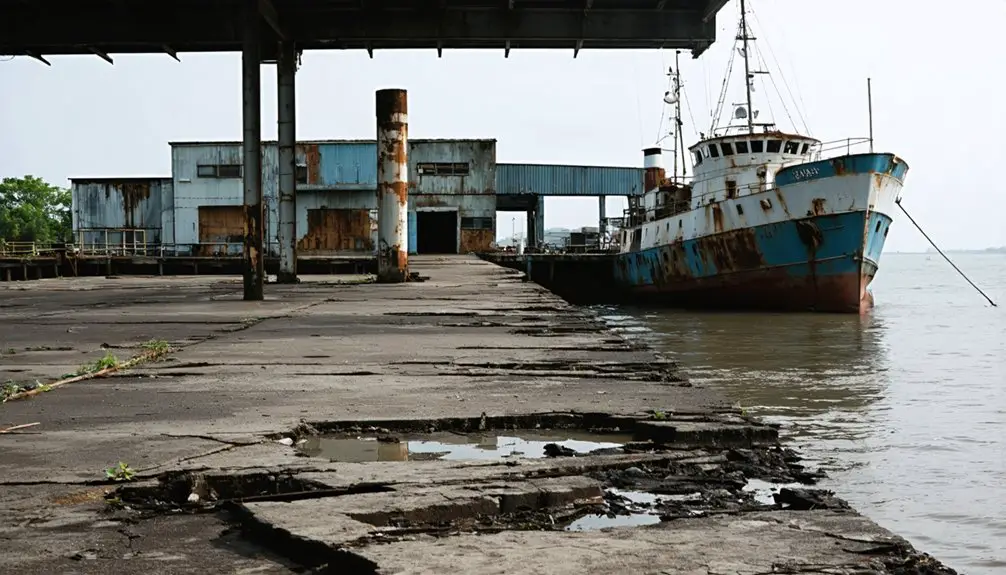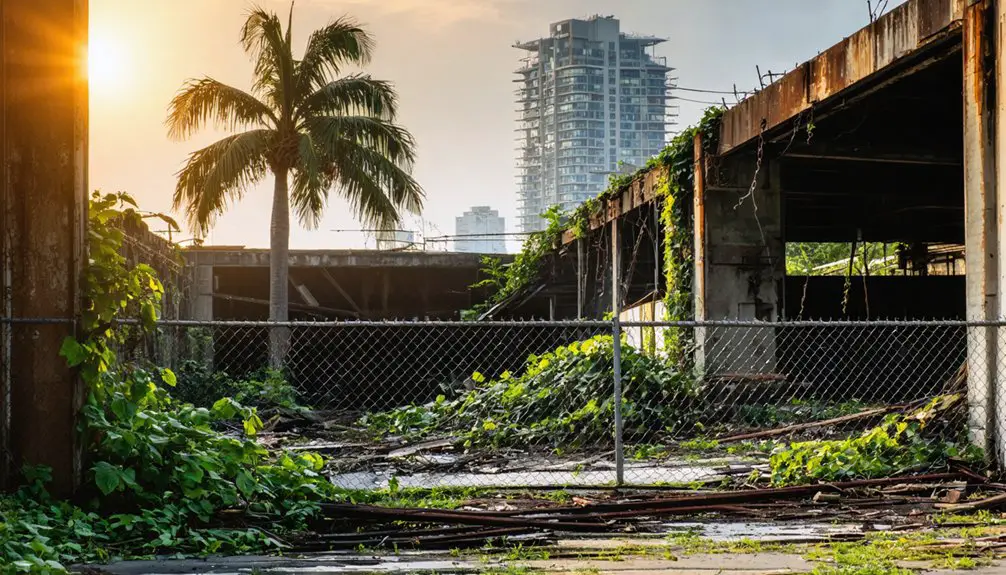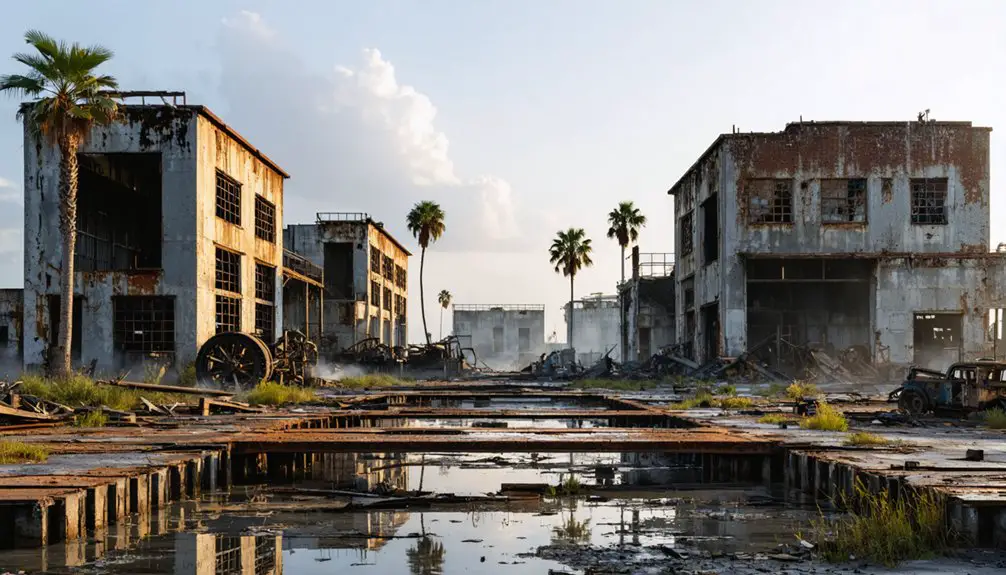You’ll find Bay Harbor‘s haunting remnants along Florida’s coast at 30°8.7’N, 85°37.3’W, where International Paper Company once powered a bustling company town. After World War II, the mill employed thousands, with workers living in uniform wooden houses and working 12-hour shifts. By the 1990s, global market shifts and industrial consolidation turned this industrial powerhouse into a ghost town. Today, weathered homes and crumbling infrastructure tell silent stories of Bay Harbor’s paper-making past.
Key Takeaways
- Bay Harbor transformed from a thriving industrial center to a ghost town after its paper mill closed and consolidated operations elsewhere.
- The town’s economic collapse stemmed from over-dependence on interconnected industries: phosphate mining, timber operations, and maritime shipping.
- Essential infrastructure deteriorated in the 1990s, with the post office’s demolition and roads falling into disrepair.
- Most original structures were demolished, leaving only a few weathered homes as evidence of the former company town.
- The area’s decline was accelerated by environmental challenges, including hurricane damage and industrial pollution that diminished its appeal.
The Rise of Bay Harbor’s Paper Mill Industry
As the cornerstone of Bay Harbor’s development, the paper mill transformed a quiet stretch of Bay County, Florida into a bustling industrial center before the 1940s.
When International Paper Company took charge, they accelerated the mill’s growth through innovative technologies and expanded infrastructure, especially after World War II.
You’ll find that the mill’s workforce culture shaped every aspect of Bay Harbor’s identity, from its residential patterns to its economic foundation.
The mill innovations of the post-war period positioned Bay Harbor as an essential hub in America’s paper production network.
The Myles Andrews family and thousands of others found stable employment and housing opportunities through the growing industrial operations.
As demand for paper products soared, the facility grew dramatically, bringing new jobs and prosperity.
The town you’d have seen then was purpose-built around the mill, with homes and businesses springing up to support the thriving industrial workforce.
Geographic Location and Natural Resources
You’ll find Bay Harbor’s strategic position in Florida’s Panhandle at 30°8.7’N, 85°37.3’W placed it perfectly for accessing both coastal shipping routes and inland pine forests.
Modern GPS navigation systems allow precise tracking of the area’s historical boundaries and natural features. The mill’s location near waterways allowed for efficient transport of finished paper products while the surrounding pine stands provided an abundant source of raw materials.
The dense forests stretched for miles in every direction, offering the mill a seemingly endless supply of the long-leaf pine trees essential for paper production. The area’s current 7.85 acres provides ample space for future development while maintaining its natural character.
Strategic Coastal Mill Position
The strategic positioning of Bay Harbor’s mill along Biscayne Bay’s northern reaches proved instrumental to its operational success.
You’ll find the mill’s coastal advantages leveraged both the sheltered waters of Biscayne Bay and direct access to Atlantic shipping lanes, creating an ideal setup for maritime operations. The natural harbor’s calm waters made docking and loading safer than open ocean sites, while the bay’s geography minimized costly dredging needs.
The mill’s efficiency thrived thanks to its location within Miami-Dade County’s bustling infrastructure. Sitting at 7 feet above sea level provided optimal elevation for the facility’s operations. The facility’s total operational footprint encompassed 0.42 square miles of valuable coastal property.
You could transport goods through multiple channels – sea, rail, or truck – while the flat terrain simplified facility expansion. The tropical climate meant year-round operations, and you’d benefit from coastal winds influencing lumber drying processes, ultimately enhancing product quality.
Pine Forest Raw Materials
While Bay Harbor’s industrial success relied heavily on its coastal location, the surrounding pine forests provided an equally vital foundation for the mill’s operations.
You’ll find these forests stretched across Florida’s coastal regions, where longleaf and slash pine species dominated the landscape. The sandy, well-drained soils created perfect conditions for these hardy trees, which supplied essential raw materials for lumber, paper, and turpentine production.
The economic impact of these pine forests extended beyond simple timber harvesting – they yielded valuable oleoresin for turpentine, pine cones for reforestation, and bark for mulch.
Nature’s own fire ecology helped maintain these forests, clearing out competing hardwoods and ensuring a steady supply of pine resources for Bay Harbor’s thriving industrial operations.
Life in a Company Town
If you’d lived in Bay Harbor during its heyday, you would’ve resided in one of the company’s uniform wooden houses, arranged in neat rows based on your position at the mill.
Your daily routine would’ve revolved entirely around the mill’s schedule, with the piercing whistle marking the start of each shift and the company store being your main source for household goods.
The houses closest to the mill went to the supervisors, while regular workers occupied the smaller cottages further out, creating distinct social boundaries within the community.
Much like the Tampa and Gulf Coast Railroad transformed nearby communities in 1914, Bay Harbor’s mill brought unprecedented industrial development to the region.
When the paper mill opened in 1938, it marked a significant turning point for the town’s economy and social structure.
Mill Housing Communities
Living in Bay Harbor’s company town meant surrendering personal autonomy for economic stability, as mill workers and their families occupied modest wood-frame houses built within walking distance of the mill.
You’d find worker housing arranged in uniform rows, maximizing space while keeping employees under the watchful eye of management. While the close quarters fostered tight-knit community dynamics, they also meant limited privacy and shared hardships.
Your rent would’ve been automatically deducted from your paycheck, and you’d likely shop at the company store, often falling into cycles of debt. The Sheip Lumber Company operated sawmills on the property until the late 1940s, providing steady employment for local families. The mill’s daily production reached 75,000 feet of lumber, making it a significant employer in the region.
Yet despite these constraints, neighbors formed resilient bonds through church gatherings, community events, and shared experiences.
The houses might’ve lacked modern amenities, but they sheltered generations of workers who built lasting connections within Bay Harbor’s industrial confines.
Daily Worker Routines
Working at Bay Harbor’s mills meant following a strict daily rhythm that began before dawn. You’d head to your 10-12 hour shift, where you’d operate heavy machinery, handle timber, or manage the power plant – all while keeping an eye on strict production quotas.
Much like the early days of Fort Brooke’s trade, the lumber business relied heavily on maritime shipping routes. Worker schedules left little room for breaks, and you’d grab quick meals near your workstation.
The work was dangerous. You’d breathe in sawdust while dodging the hazards of massive saws and crushing equipment. Safety measures existed but were basic at best. If you got hurt, medical care was limited in the company town.
After your shift, physical exhaustion would follow you home. Your evenings belonged to brief family time and company-sanctioned social events, always mindful that tomorrow would bring another dawn at the mill.
Economic Dependencies and Vulnerabilities
While Bay Harbor initially showed promise as a bustling port town, its economic foundation rested precariously on a handful of interdependent industries.
You’d find the town’s lifeblood flowing through phosphate mines, timber operations, and maritime shipping – all tightly woven together in a vulnerable web of economic concentration.
The town bet everything on resource volatility, with 5,544 phosphate-related jobs in 2001 defining the region’s prosperity.
You couldn’t separate the success of one sector from another – the fertilizer plants needed the mines, the port needed the cargo, and the railways needed both.
When global phosphate demands shifted or environmental regulations tightened, there was nowhere to hide.
The lack of industrial diversity left Bay Harbor exposed, much like a ship caught in a storm with only one anchor.
The Path to Abandonment

As economic pillars crumbled one by one, Bay Harbor’s path to abandonment unfolded through a perfect storm of setbacks in the late 20th century.
Like dominoes falling in slow motion, Bay Harbor’s decline marked an era where industry, community, and hope vanished together.
You’d have witnessed dramatic demographic shifts as the paper mill, once the town’s lifeblood, consolidated operations elsewhere, leaving workers with little choice but to seek opportunities in other communities.
Infrastructure decline followed swiftly – the post office’s demolition in the 1990s marked a symbolic end to community life. Roads fell into disrepair, and essential services dwindled.
Nature took its toll too, with hurricanes and harsh weather battering the remaining structures. Industrial pollution from the mill’s legacy made the area less appealing for potential newcomers.
Today, you’ll find only scattered homes among sprawling industrial properties – silent witnesses to Bay Harbor’s transformation from bustling mill town to forgotten ghost town.
Industrial Heritage and Legacy
Before its decline, Bay Harbor stood as a symbol of Florida’s industrial might, where lumber mills and phosphate processing facilities shaped both the landscape and community identity.
The industrial nostalgia lives on through preserved buildings elsewhere in Pinellas County, while the labor legacy echoes in the stories of former workers who once called this bustling port town home.
- Maritime workers and mill operators transformed raw materials into valuable exports
- Railroad lines and deep-water channels still trace the pathways of commerce
- Historic industrial architecture stands as a monument to Bay Harbor’s working past
You’ll find Bay Harbor’s influence woven into the fabric of Florida’s Gulf Coast development, from the altered landscapes to the migration patterns of workers who adapted to changing economic tides.
The community’s resilience during economic transformation remains documented in local archives and oral histories.
Modern-Day Site Transformation

The transformation of Bay Harbor Islands into a modern commercial hub marks a dramatic shift from its ghost town past.
You’ll find urban renewal in full swing with projects like One Kane Concourse, a $74 million waterfront development that’s bringing Class A office spaces and private boat access by 2026.
The area’s community engagement is evident in carefully planned infrastructure upgrades, with new traffic signals being installed during daylight hours to minimize disruption.
You’re witnessing a complete metamorphosis as mixed-use developments attract corporate tenants like Dwight Capital, while ground-floor restaurants and rooftop terraces create vibrant streetscapes.
Despite rising interest rates, the area’s commercial real estate remains hot, with rental rates competitive at $9.50 to $11.00 per square foot for premium spaces.
Preservation Status and Historical Records
While industrial development has largely erased Bay Harbor’s historic fabric, you’ll find its remnants subsumed within the Panama City Paper Mill property today.
The historical significance of this once-bustling port town faces serious preservation challenges, with most original structures demolished in the 1990s. You won’t discover any formal preservation programs or historical markers on-site, and public access is restricted due to industrial operations.
- A few weathered homes still stand as silent witnesses to Bay Harbor’s past
- Historical documentation remains scarce, with most records focusing on paper mill operations
- The site represents Florida’s industrial heritage, though its physical traces are vanishing
The town’s story mirrors many Florida ghost towns where economic shifts led to abandonment, leaving behind fragmentary evidence of its paper mill legacy.
Frequently Asked Questions
What Was the Peak Population of Bay Harbor During Its Most Prosperous Years?
While you’ll hear ghost stories about Bay Harbor’s industrial history, there’s no documented peak population count – records don’t reveal exact numbers from this Florida ghost town’s most prosperous period.
Were There Any Schools or Churches Established in Bay Harbor?
Like an empty canvas awaiting its first brushstroke, Bay Harbor never developed any schools established or church history. You won’t find records of educational or religious institutions in this industrial settlement.
What Year Was the Paper Mill Originally Constructed in Bay Harbor?
You won’t find the exact paper mill construction date in available records. While the mill’s history is tied to Bay Harbor’s development, specific details about when it was built remain unclear.
Did Any Notable Disasters or Accidents Occur at the Bay Harbor Mill?
Though mill accidents and industrial disasters plagued many facilities, you won’t find any documented catastrophes at Bay Harbor Mill. History’s records are remarkably silent about major incidents at this location.
What Happened to the Residents After Bay Harbor Became Abandoned?
You’ll find most residents moved to Panama City seeking jobs, while others scattered across Bay County. Though relocation stories mention some stayed nearby, watching their hometown fade into memory.
References
- https://en.wikipedia.org/wiki/Bay_Harbor
- https://www.florida-backroads-travel.com/florida-ghost-towns.html
- https://www.ghosttowns.com/states/fl/bayharbor.html
- https://abandonedfl.com/class/industrial/page/2/
- https://abandonedfl.com
- https://www.hmdb.org/m.asp?m=245437
- https://www.bayharborislands-fl.gov/235/History
- https://www.coordinatesfinder.com/coordinates/1908818-fl-bay-harbor-is
- https://www.loopnet.com/property/11656-bay-harbor-blvd-san-antonio-fl-33576/12101-1025200000003000120/
- https://latitude.to/articles-by-country/us/united-states/45666/bay-harbor-islands-florida



